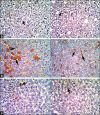Toxicological and biochemical studies on Schinus terebinthifolius concerning its curative and hepatoprotective effects against carbon tetrachloride-induced liver injury
- PMID: 26109780
- PMCID: PMC4461974
- DOI: 10.4103/0973-1296.157705
Toxicological and biochemical studies on Schinus terebinthifolius concerning its curative and hepatoprotective effects against carbon tetrachloride-induced liver injury
Abstract
Background: Recently, many efforts have been made to discover new products of natural origin which can limit the xenobiotic-induced hepatic injury. Carbon tetrachloride (CCl4) is a highly toxic chemical that is widely used to study hepatotoxicity in animal models.
Objective: The present study was conducted to investigate the curative and protective effects of Schinus terbenthifolius ethanolic extract against CCl4 -induced acute hepatotoxicity in rats.
Materials and methods: S. terbenthifolius extract was orally administered in a dose of 350 mg dried extract/kg b.wt. before and after intoxication with CCl4 for curative and protective experiments, respectively. A group of hepatotoxicity indicative enzymes, oxidant-antioxidant capacity, DNA oxidation, and apoptosis markers were measured.
Results: CCl4 increased liver enzyme leakage, oxidative stress, hepatic apoptosis, DNA oxidation, and inflammatory markers. Administration of S. terebinthifolius, either before or after CCl4 intoxication, significantly decreased elevated serum liver enzymes and reinstated the antioxidant capacity. Interestingly, S. terebinthifolius extract inhibited hepatocyte apoptosis as revealed by approximately 20 times down-regulation in caspase-3 expression when compared to CCl4 untreated group. On the other hand, there was neither protective nor curative effect of S. terebinthifolius against DNA damage caused by CCl4.
Conclusion: The present study suggests that S. terebinthifolius extract could be a substantially promising hepatoprotective agent against CCl4 toxic effects and may be against other hepatotoxic chemical or drugs.
Keywords: Antioxidant; Schinus terebinthifolius; apoptosis; hepatoprotective; hepatotoxicity.
Conflict of interest statement
Figures

Similar articles
-
Antioxidant and hepatoprotective activity of Fagonia schweinfurthii (Hadidi) Hadidi extract in carbon tetrachloride induced hepatotoxicity in HepG2 cell line and rats.J Ethnopharmacol. 2013 Dec 12;150(3):973-81. doi: 10.1016/j.jep.2013.09.048. Epub 2013 Oct 17. J Ethnopharmacol. 2013. PMID: 24140589
-
Pharmacological Evaluation of Hepatoprotective Activity of AHPL/AYTAB/0613 Tablet in Carbon Tetrachloride-, Ethanol-, and Paracetamol-Induced Hepatotoxicity Models in Wistar Albino Rats.Pharmacognosy Res. 2017 Dec;9(Suppl 1):S41-S47. doi: 10.4103/pr.pr_44_17. Pharmacognosy Res. 2017. PMID: 29333041 Free PMC article.
-
Efficient hepatoprotective activity of cranberry extract against CCl4-induced hepatotoxicity in Wistar albino rat model: Down-regulation of liver enzymes and strong antioxidant activity.Asian Pac J Trop Med. 2017 Nov;10(11):1054-1058. doi: 10.1016/j.apjtm.2017.10.008. Epub 2017 Oct 27. Asian Pac J Trop Med. 2017. PMID: 29203101
-
Hepatoprotective activity of ethanolic extract of Salix subserrata against CCl4-induced chronic hepatotoxicity in rats.BMC Complement Altern Med. 2016 Jul 29;16:263. doi: 10.1186/s12906-016-1238-2. BMC Complement Altern Med. 2016. PMID: 27473536 Free PMC article.
-
Toxicity of carbon tetrachloride, free radicals and role of antioxidants.Rev Environ Health. 2020 Sep 25;36(2):279-295. doi: 10.1515/reveh-2020-0048. Print 2021 Jun 25. Rev Environ Health. 2020. PMID: 32970608 Review.
Cited by
-
Medicinal Plants from Brazilian Cerrado: Antioxidant and Anticancer Potential and Protection against Chemotherapy Toxicity.Oxid Med Cell Longev. 2019 Aug 25;2019:3685264. doi: 10.1155/2019/3685264. eCollection 2019. Oxid Med Cell Longev. 2019. PMID: 31534620 Free PMC article. Review.
-
Protective role of quercetin against manganese-induced injury in the liver, kidney, and lung; and hematological parameters in acute and subchronic rat models.Drug Des Devel Ther. 2017 Sep 5;11:2605-2619. doi: 10.2147/DDDT.S143875. eCollection 2017. Drug Des Devel Ther. 2017. Retraction in: Drug Des Devel Ther. 2019 Mar 18;13:907-908. doi: 10.2147/DDDT.S207534. PMID: 28919711 Free PMC article. Retracted.
References
-
- Madkour FF, Khalil WF, Dessouki AA. Protective effect of ethanol extract of Sargassum Dentifolium (Phaeophyceae) in carbon tetrachloride induced hepatitis in rats. Int J Pharm Pharm Sci. 2012;4:637–41.
-
- Gupta M, Mazumder UK, Thamilselven V, Manikandan L, Senthilkumar GP. Potential hepatoprotective effect and antioxidant role of ethanol extract of Oldenlandia umbellate in carbon tetrachloride induced hepatotoxicity in Wistar rats. Iran J Pharmacol Ther. 2007;6:5–9.
-
- Pari L, Murugan P. Protective role of tetrahydrocurcumin against erythromycin estolate-induced hepatotoxicity. Pharmacol Res. 2004;49:481–6. - PubMed
-
- Halliwell B, Gutteridge JM. 3rd ed. New York: Oxford University Press; 1999. Free Radicals in Biology and Medicine; pp. 617–783.
-
- Stal P, Olson J. Ubiquinone: Oxidative stress, and liver carcinogenesis. In: Kagan VE, Quinn DJ, editors. Coenzyme Q: Molecular Mechanisms in Health and Disease. Boca Raton: CRC Press; 2000. pp. 317–29.
LinkOut - more resources
Full Text Sources
Other Literature Sources
Research Materials
